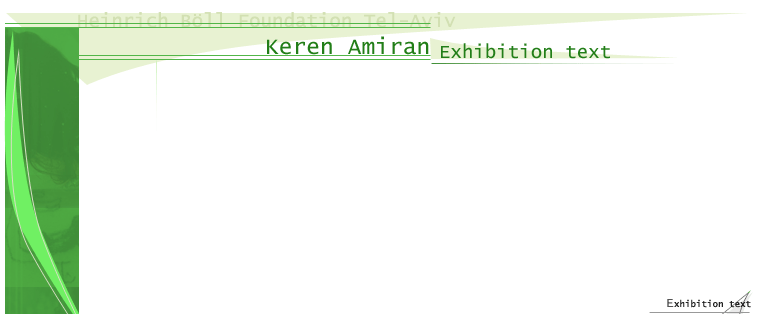


"Ehad Haam"
by Karen Amiran
Karen Amiran In the photographic installation "Ehad Haam" (The Heinrich B?ll Foundation, February-March), I presented 28 photographs of Ehad Haam Street. The street was photographed in all the cities in Israel in a street bearing this name exists, except for Ehad Haam Street in Tel-Aviv. This street, which is familiar to me from my urban daily life in Tel-Aviv, served as a point of reference from which I departed to the other streets throughout Israel.
In all the photographs, the photographic practice is based on the image of photography as a documentary medium, as a means of collecting and organizing information. The hour in which the photographs were taken is more or less the same, and the photography angle is wide in order to include as many visual details as possible in the photograph. Such photography enables an "objective" examination of similarity, identity and identification. I sought to achieve a quality of reproduction in the photographs, a photograph of a photograph. The photographs were developed and printed in a cheap, amateur method. The final product is a colorful Zerox, stuck directly on the wall, imparting a uniform, banal look that waives printing qualities and other components that pleasure the eye.
While photographing I traveled the length and width of Israel, visiting cities I probably would never have reached were it not for this project. The absurd, almost senseless act, of driving three hours in order to reach a place the likes of which I could have seen merely half an hour from home, coming back with a frame that "does jot justify a photograph", the banal, everyday landscape, which has nothing that is unique and can be identified as artistic - this act is extremely essential to my work.
I was curious to examine the everyday Israeli street. To examine it from up close but not too up close, with a non-tendentious look, rather than the kind that is intended to attribute specific characterizations to the street. A look at the ordinary, the unattractive landscape, which we don't normally stop to look at. I was interested in the situation, reflected in the photographs, of the inability to differentiate, in many cases, between the various towns and cities. Sometimes it is difficult to discern whether the photograph is of a "poor" town or of an "affluent" city. The photograph undermines the identification of a specific town with its stereotypical imaginary picture. The question of identification-identity preoccupied me in this work. Do these streets have any similar characteristics beyond the common denominator of their name?
I included an additional photograph in this exhibition, "family", which was taken especially for the catalog, and which serves as an extension of the geographical and architectural contexts of the "Ehad Haam" photographs. Four family photographs appear in this work: my grandmother, my grandfather, my mother and my father - and under each photograph there is a caption identifying them as well-known German artists ("MY FATHER AS SIGMAR POLKE"). My family members, Jews of German origin, are culturally connected to Christian German artists, comprising a kind of artistic family. This work is an additional aspect of the identification-identity relations, which is also found in the "Ehad Haam" work - through the relation between the private, biographical name of the man, a name chosen by his parents, and the name he adopted, with its public-national contexts. Between the man and all he represents and the various streets bearing the name he chose for himself, there is a stratified cultural mediation system, which is a blend of rational explanations and arbitrary circumstances (why this name was given to a particular street, the relation to nearby streets, etc.).
'Ehad Haam' (1856-1927) was born in the Ukraine and died in Tel-Aviv. He was a Zionist Jew whose given name was Asher Zvi Ginzberg. In an article he wrote in 1889, titled "This is Not the Way!", Ginzberg used the nom de plume 'Ehad Haam' ("One of the People"), and since then he was identified with this name. "With this signature I wished to say that I am not a writer, and I have no intention of oining the ranks of writers in the future, it is only by chance that I disclose my opinion on this subject, as one of the people who is concerned with the problems of his people" (Ehad Haam, "Memoirs"). In a certain sense, I form a parallelism between his position in writing and my position in photography. I am not a photographer, and I have no intention… and only by chance, as a concerned artist…
 |
|
|||
|
|
|
|
||
|
|
|
 |
|
|
|
|
|
|||
|
|
 |
|
||